Teaching Technique: Model (I Do)
Practice Modules
Overview
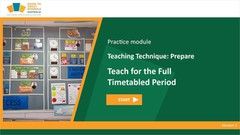
Prepare: Teach for the Full Timetabled Period
Teach for the full timetable period is a practice module that goes in depth for participants to learn what happens when the technique is delivered with fidelity. They learn what happens when teaching for the full timetable period is not delivered with fidelity, the barriers and how to overcome the barriers to deliver teaching for the full timetable period with fidelity.
Learning Intents
- Demonstrate techniques that engage students and deliver lesson components to fidelity (TS1.2) (3.1.02).
- Understand basic direct instruction techniques and why they are used. Understand basic explicit instruction teaching techniques and why they are used. Demonstrate mastery of basic direct and explicit instruction techniques through weekly program practice sessions and then in classroom delivery (TS1.3) (3.1.03).
- Understand components of effective teaching resources (such as the Teacher Guide) that align with core programs. Demonstrate direct and explicit instruction concepts in developing independent work that aligns to the program being taught. Communicate correct use of program components, such as Teacher Presentation Book, Teacher Guide, Student Workbooks, student books, etc. (TS1.4) (3.1.04).
- Implement lesson sequences with fidelity, maintaining student engagement and promoting learning (TS1.9) (3.1.09).
- Review key teaching techniques with colleagues in weekly practice sessions (TS1.10) (3.1.10).
- Understand basic effective teaching techniques and practices in academics and behaviour. Demonstrate ability to teach lessons using direct and explicit instruction teaching techniques (TS2.1) (3.2.01).
- Plan lesson presentation using direct and explicit instruction teaching techniques (TS2.7) (3.2.07).
- Understand how to group students and maximise instructional time to manage classroom activities. Apply classroom practices across all activities by setting clear behavioural expectations and facilitating routines, orderly transitions and bell to bell teaching. Demonstrate effective use of instructional time by managing classroom (TS4.2) (3.4.02).
- Plan how to group students and maximise instructional time to manage classroom activities. Implement plan to facilitate routines, orderly transitions and bell to bell teaching (TS4.7) (3.4.07).
Duration
- 4 lessons.
Assessment
Assessment has two stages:
- Test: Knowledge and skills taught in the lessons
- Observation: Delivery with students of the knowledge and skills learned in the lessons.
Certification
- None.
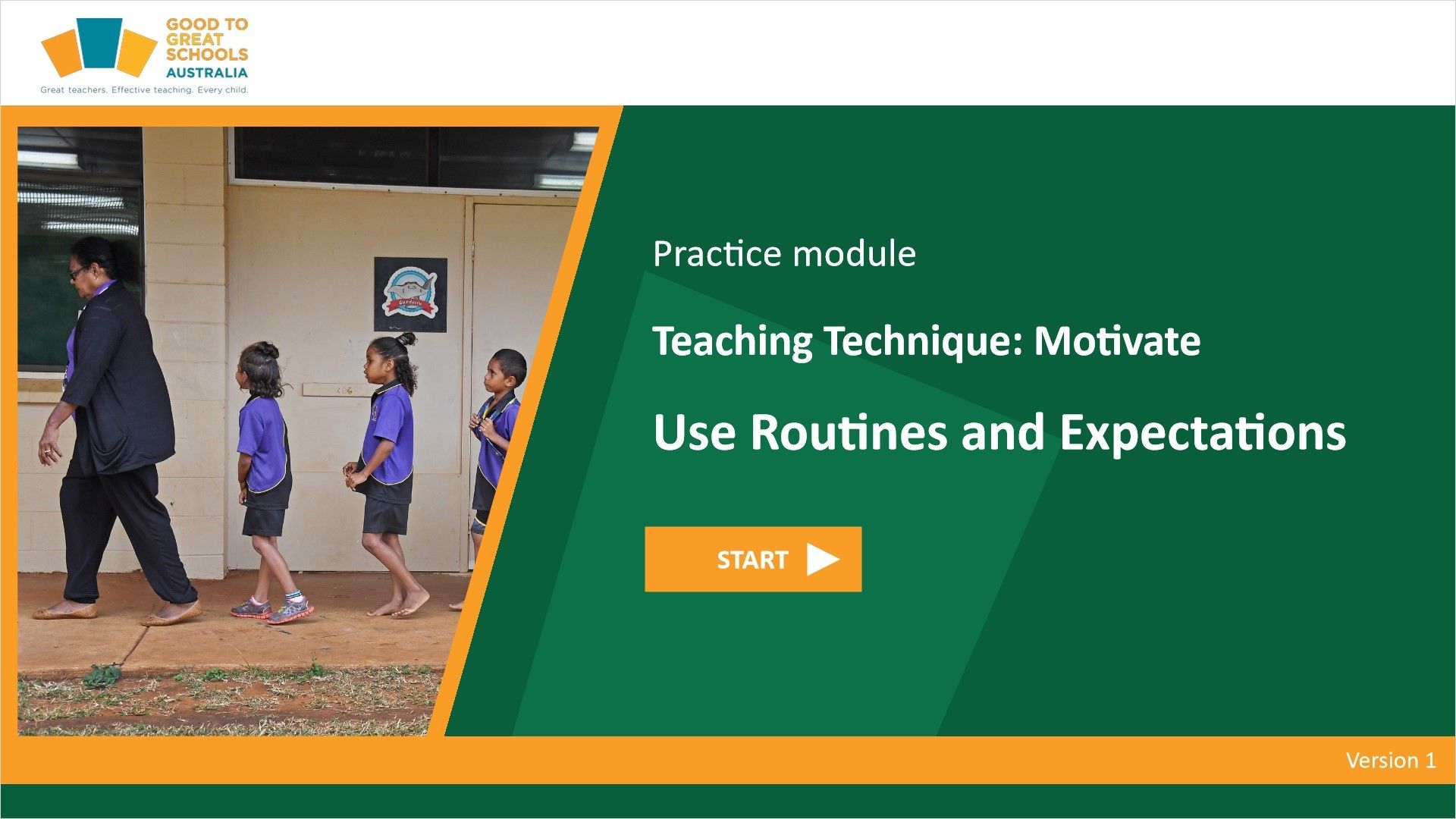
Motivate: Use Routines and Expectations
Use Routines and Expectations is a practice module that goes in depth for participants to learn what happens when the technique is delivered with fidelity. They learn what happens when using routines and expectations is not delivered with fidelity. They also learn how to overcome the barriers to deliver using routines and expectations with fidelity.
Learning Intents
- Demonstrate techniques that engage students and deliver lesson components to fidelity (TS1.2) (3.1.02).
- Understand basic direct instruction techniques and why they are used. Understand basic explicit instruction teaching techniques and why they are used. Demonstrate mastery of basic direct and explicit instruction techniques through weekly program practice sessions and then in classroom delivery (TS1.3) (3.1.03).
- Understand components of effective teaching resources (such as the Teacher Guide) that align with core programs. Communicate correct use of program components, such as Teacher Presentation Book, Teacher Guide, Student Workbooks, student books, etc. (TS1.4) (3.1.04).
- Implement lesson sequences with fidelity, maintaining student engagement and promoting learning (TS1.9) (3.1.09).
- Understand basic effective teaching techniques and practices in academics and behaviour. Demonstrate ability to teach lessons using direct and explicit instruction teaching techniques (TS2.1) (3.2.01).
- Plan lesson presentation using direct and explicit instruction teaching techniques. Implement all parts of direct and explicit instruction lessons (TS2.7) (3.2.07).
- Understand principles of effective teaching and how it is targeted to students to meet the physical, social and intellectual development and characteristics of students (TS3.1) (3.3.01).
- Apply social emotional learning to develop pro-social behaviours and reinforce self-regulation. Apply school rules across classrooms and play areas. Communicate feedback about students’ behaviour within the classroom using character strengths, teacher–student game, charts and reinforcers (TS4.1) (3.4.01).
Duration
- 4 Lessons.
Assessment
Assessment has two stages:
- Test: Knowledge and skills taught in the lessons
- Observation: Delivery with students of the knowledge and skills learned in the lessons.
Certification
- None.
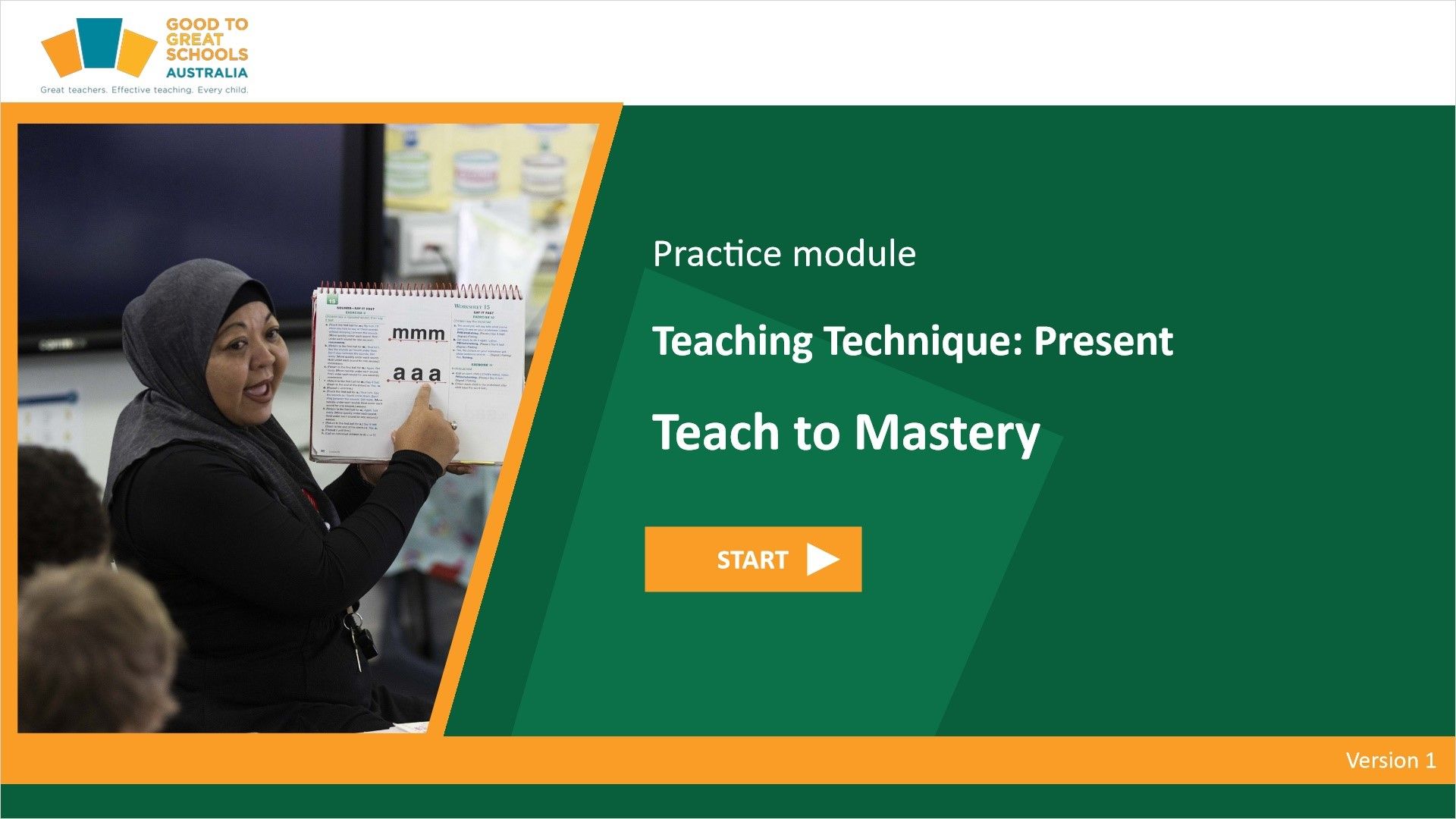
Present: Teach to Mastery
Teach to Mastery is a practice module that goes in depth for participants to learn what happens when the technique is delivered with fidelity. They learn what happens when teaching to mastery is not delivered with fidelity. They also learn how to overcome the barriers to delivering teaching to mastery with fidelity.
Learning Intents
- Demonstrate techniques that engage students and deliver lesson components to fidelity (TS1.2) (3.1.02).
- Understand basic direct instruction techniques and why they are used. Understand basic explicit instruction teaching techniques and why they are used. Demonstrate mastery of basic direct and explicit instruction techniques through weekly program practice sessions and then in classroom delivery (TS1.3) (3.1.03).
- Understand components of effective teaching resources (such as the Teacher Guide) that align with core programs.
- Demonstrate direct and explicit instruction concepts in developing independent work that aligns to the program being taught. Communicate correct use of program components, such as Teacher Presentation Book, Teacher Guide, Student Workbooks, student books, etc. (TS1.4) (3.1.04).
- Implement re-teaching or skipping of direct instruction lessons, based on group mastery data, and in collaboration with instruction coach. Review direct instruction student mastery data daily to ensure groups stay at mastery. Review explicit instruction student mastery data daily to ensure groups stay at mastery (TS1.8) (3.1.08).
- Implement lesson sequences with fidelity, maintaining student engagement and promoting learning (TS1.9) (3.1.09).
- Review key teaching techniques with colleagues in weekly practice sessions (TS1.10) (3.1.10).
- Understand basic effective teaching techniques and practices in academics and behaviour. Demonstrate ability to teach lessons using direct and explicit instruction teaching techniques (TS2.1) (3.2.01).
- Plan lesson presentation using direct and explicit instruction teaching techniques. Implement all parts of direct and explicit instruction lessons (TS2.7) (3.2.07).
- Plan group instruction based on mastery data and program guidelines. Implement direct and explicit instruction lessons with fidelity (TS4.8) (3.4.08).
Duration
- 4 Lessons.
Assessment
Assessment has two stages:
- Test: Knowledge and skills taught in the lessons
- Observation: Delivery with students of the knowledge and skills learned in the lessons.
Certification
- None.
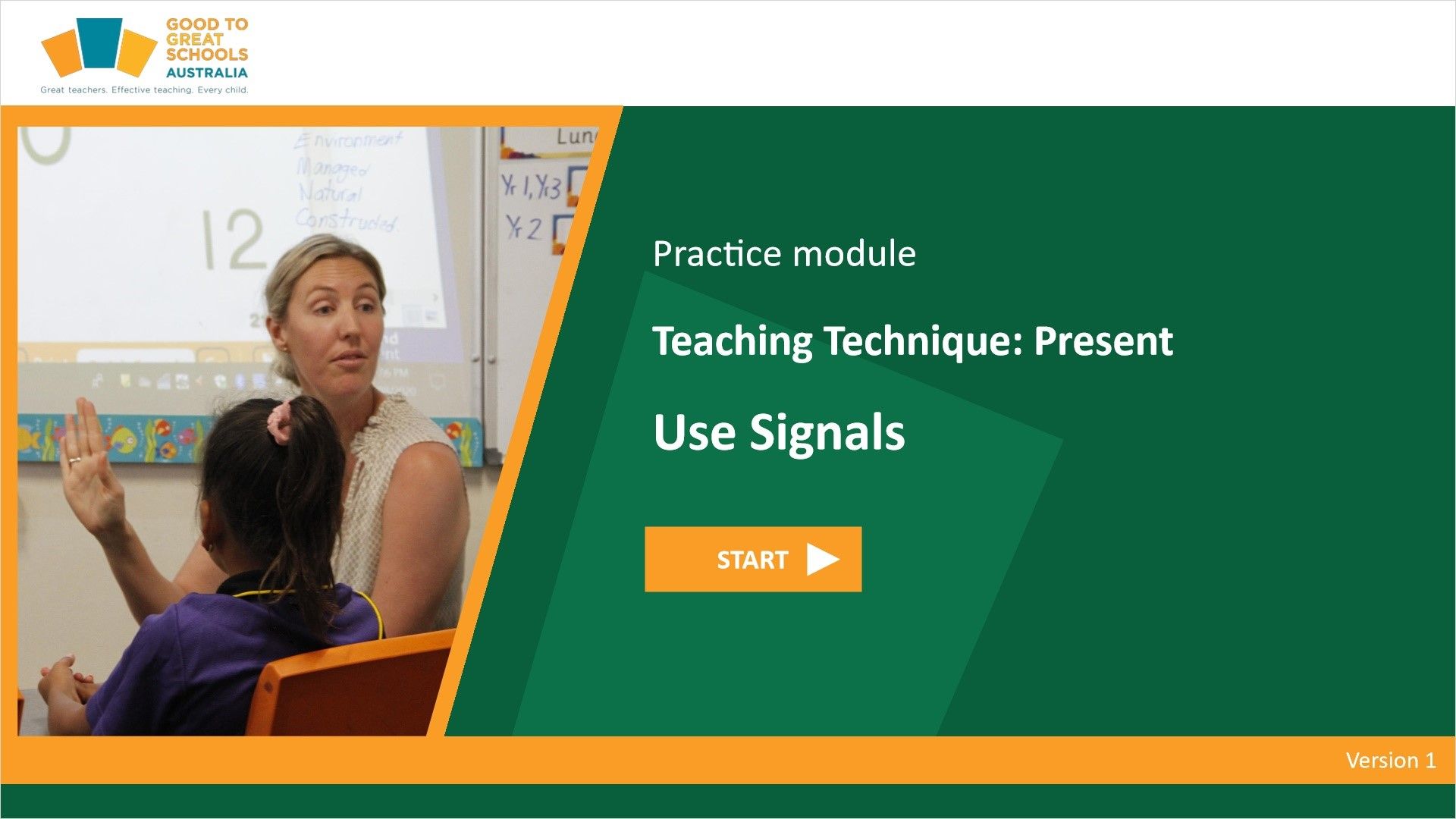
Present: Use Signals
Use Signals is a practice module that goes in depth for participants to learn what happens when the technique is delivered with fidelity. They learn what happens when using signals is not delivered with fidelity. They also learn how to overcome the barriers to delivering using signals with fidelity.
Learning Intents
- Demonstrate techniques that engage students and deliver lesson components to fidelity (TS1.2) (3.1.02).
- Understand basic direct instruction techniques and why they are used. Understand basic explicit instruction teaching techniques and why they are used. Demonstrate mastery of basic direct and explicit instruction techniques through weekly program practice sessions and then in classroom delivery (TS1.3) (3.1.03).
- Understand components of effective teaching resources (such as the Teacher Guide) that align with core programs. Communicate correct use of program components, such as Teacher Presentation Book, Teacher Guide, Student Workbooks, student books, etc. (TS1.4) (3.1.04).
- Implement lesson sequences with fidelity, maintaining student engagement and promoting learning (TS1.9) (3.1.09).
- Review key teaching techniques with colleagues in weekly practice sessions (TS1.10) (3.1.10).
- Understand basic effective teaching techniques and practices in academics and behaviour. Demonstrate ability to teach lessons using direct and explicit instruction teaching techniques (TS2.1) (3.2.01).
- Plan lesson presentation using direct and explicit instruction teaching techniques. Implement all parts of direct and explicit instruction lessons (TS2.7) (3.2.07).
Duration
- 4 Lessons.
Assessment
Assessment has two stages:
- Test: Knowledge and skills taught in the lessons
- Observation: Delivery with students of the knowledge and skills learned in the lessons.
Certification
- None.
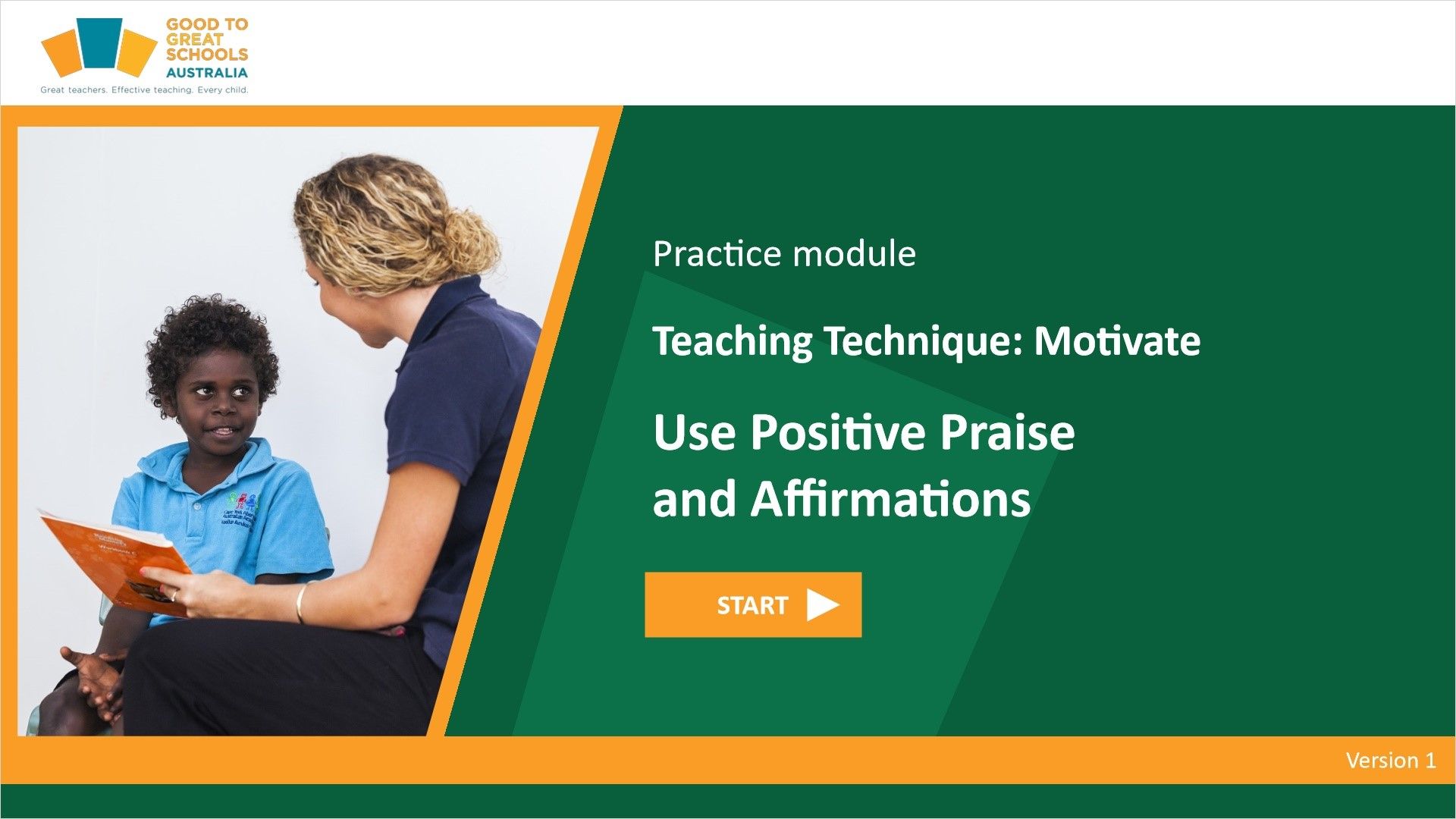
Motivate: Use Positive Praise and Affirmations
Practice Provide Positive Praise and Affirmations is a practice module that goes in depth for participants to learn what happens when the technique is delivered with fidelity. They learn what happens when using positive praise and affirmations is not delivered with fidelity. The barriers and how to overcome the barriers to deliver using positive praise and affirmations with fidelity.
Learning Intents
- Demonstrate techniques that engage students and deliver lesson components to fidelity (TS1.2) (3.1.02).
- Understand basic direct instruction techniques and why they are used. Understand basic explicit instruction teaching techniques and why they are used. Demonstrate mastery of basic direct and explicit instruction techniques through weekly program practice sessions and then in classroom delivery (TS1.3) (3.1.03).
- Understand components of effective teaching resources (such as the Teacher Guide) that align with core programs. Communicate correct use of program components, such as Teacher Presentation Book, Teacher Guide, Student Workbooks, student books, etc. (TS1.4) (3.1.04).
- Implement lesson sequences with fidelity, maintaining student engagement and promoting learning (TS1.9) (3.1.09).
- Understand basic effective teaching techniques and practices in academics and behaviour. Demonstrate ability to teach lessons using direct and explicit instruction teaching techniques (TS2.1) (3.2.01).
- Plan lesson presentation using direct and explicit instruction teaching techniques. Implement all parts of direct and explicit instruction lessons (TS2.7) (3.2.07).
- Understand principles of effective teaching and how it is targeted to students to meet the physical, social and intellectual development and characteristics of students (TS3.1) (3.3.01).
- Apply social emotional learning to develop pro-social behaviours and reinforce self-regulation. Apply school rules across classrooms and play areas. Communicate feedback about students’ behaviour within the classroom using character strengths, teacher–student game, charts, and reinforcers (TS4.1) (3.4.01).
Duration
- 4 Lessons.
Assessment
Assessment has two stages:
- Test: Knowledge and skills taught in the lessons
- Observation: Delivery with students of the knowledge and skills learned in the lessons.
Certification
- None.
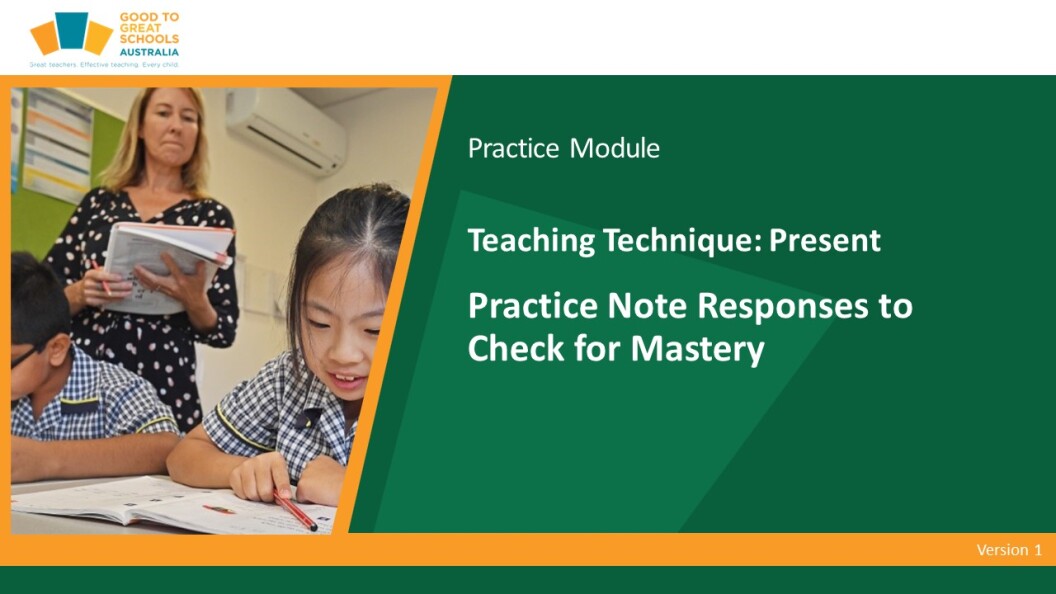
Practice Note Responses to Check for Mastery
Note Responses to Check for Understanding is a practice module that goes in depth for participants to learn what happens when the technique is delivered with fidelity. They learn what happens when noting responses to check for understanding is not delivered with fidelity. They also learn how to overcome the barriers to delivering note responses to check for understanding with fidelity.
Learning Intents
- Demonstrate techniques that engage students and deliver lesson components to fidelity (TS1.2) (3.1.02).
- Understand basic direct instruction techniques and why they are used. Understand basic explicit instruction teaching techniques and why they are used. Demonstrate mastery of basic direct and explicit instruction techniques through weekly program practice sessions and then in classroom delivery (TS1.3) (3.1.03).
- Understand components of effective teaching resources (such as the Teacher Guide) that align with core programs. Demonstrate direct and explicit instruction concepts in developing independent work that aligns to the program being taught. Communicate correct use of program components, such as Teacher Presentation Book, Teacher Guide, Student Workbooks, student books, etc. (TS1.4) (3.1.04).
- Implement re-teaching or skipping of direct instruction lessons based on group mastery data and in collaboration with instruction coach. Review direct instruction student mastery data daily to ensure groups stay at mastery. Review explicit instruction student mastery data daily to ensure groups stay at mastery (TS1.8) (3.1.08).
- Implement lesson sequences with fidelity, maintaining student engagement and promoting learning (TS1.9) (3.1.09).
- Review key teaching techniques with colleagues in weekly practice sessions (TS1.10) (3.1.10).
- Understand basic effective teaching techniques and practices in academics and behaviour. Demonstrate ability to teach lessons using direct and explicit instruction teaching techniques (TS2.1) (3.2.01).
- Plan lesson presentation using direct and explicit instruction teaching techniques. Implement all parts of direct and explicit instruction lessons (TS2.7) (3.2.07).
- Plan group instruction based on mastery data and program guidelines. Implement direct and explicit instruction lessons with fidelity (TS4.8) (3.4.08).
Duration
- 4 Lessons.
Assessment
Assessment has two stages:
- Test: Knowledge and skills taught in the lessons
- Observation: Delivery with students of the knowledge and skills learned in the lessons.
Certification
None.
